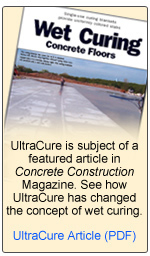| |
|
|
|
|
|
|
|

EZdowel® Load transfer System meets new ACI 360 Guidelines
Chapter 6 of the new 2010 ACI 360 Guide to Design of Slabs on Ground has been released and, as in the past, the guide becomes the primary design and product specification tool for architects, designers, owners and contractors. Making sure that your project meets the new guidelines is critical - especially from a liability standpoint. When issues occur on a concrete floor or pavement, and litigation is the means to settle differences, the ACI 360 document becomes very important, as it will be the standard that legal consul and expert witnesses refer to. What if your project doesn’t meet the new guidelines? How much liability you can afford to assume?
The EZdowel® system from McTech Group will help your flooring or pavement design achieve top performance, and provide you with the confidence that you are meeting the latest ACI design criteria
In chapter 6 (Joints), you’ll find new criteria for slab-on-ground construction to limit vertical defection of joints in concrete floors. Chapter 6 also includes criteria for defining the acceptable limits on joint deflection plus providing the designer with performance guidelines on specifying load transfer devices in areas of the slab subjected to wheeled traffic, heavy loads or both. The new guidelines offer key language that provides direction for designers to specify methods and materials to the contractor during a construction project.
Chapter 6 key words:
Accurate Slotting: “Proper alignment can be achieved by rigidly attaching alignment devices to the bulkhead, or by accurately slotting or drilling the bulkhead to accept a load transfer device”, and “For dowels to be effective, they should be smooth, aligned and supported so they remain parallel in both the horizontal and vertical planes during the placing and finishing operations”. - ACI 360 (6.1.2), (6.2)
The EZdowel plate dowel is installed into pre-slotted form boards to insure accurate placement in both the vertical and horizontal planes. The system is the only system available that guarantees perfect dowel alignment. The slots are either CNC (computer numerically controlled) cut, or field cut using a jig and router system designed to provide highly accurate field cut dowel slots
Direct Contact: “Load transfer devices in direct contact with the concrete will be the most effective load transfer mechanism for controlling vertical joint deflection”. - ACI 360 (6.1.2)
EZdowel is the only plate dowel on the market that has 100% direct contact with the concrete on top and bottom of the dowel. EZdowel has 100% more direct steel surface to concrete contact than any other competitor.
Rigid Material: “When incorporating alignment or installation devices into the bulkhead, which remain in the slab, the device should be manufactured with a thin rigid material that is a tight fit with the load transfer device to minimize vertical deflection due to load”. - ACI 360 (6.1.2)
Minimizing vertical deflection is key in obtaining proper load transfer, thus reducing costly maintenance issues and extending the life of the concrete flooring. Since the EZdowel is a “direct contact” dowel, there are no plastic pocket formers which remain in the slab. Plastic could possibly crack, or compress under load, which could allow deflection. “Rigid” as defined by the American Association of State Highway and Transportation Offices (AASHTO) is: “The ability to resist deformation when subjected to a load,” Which is exactly what a proper load transfer device is supposed to perform- limiting vertical deflection on both sides of a joint. In ACI 360 (6.2), Walker and Holland recommend deflections less than 10 mils to provide good service life on concrete joints.
Chapter 6 of the new 2010 ACI 360 Guide to Design of Slabs on Ground has been released and, as in the past, the guide becomes the primary design and product specification tool for architects, designers, owners and contractors. Making sure that your project meets the new guidelines is critical - especially from a liability standpoint. When issues occur on a concrete floor or pavement, and litigation is the means to settle differences, the ACI 360 document becomes very important, as it will be the standard that legal consul and expert witnesses refer to. What if your project doesn’t meet the new guidelines? How much liability you can afford to assume?
The EZdowel® system from McTech Group will help your flooring or pavement design achieve top performance, and provide you with the confidence that you are meeting the latest ACI design criteria
In chapter 6 (Joints), you’ll find new criteria for slab-on-ground construction to limit vertical defection of joints in concrete floors. Chapter 6 also includes criteria for defining the acceptable limits on joint deflection plus providing the designer with performance guidelines on specifying load transfer devices in areas of the slab subjected to wheeled traffic, heavy loads or both. The new guidelines offer key language that provides direction for designers to specify methods and materials to the contractor during a construction project.
Chapter 6 key words:
Accurate Slotting: “Proper alignment can be achieved by rigidly attaching alignment devices to the bulkhead, or by accurately slotting or drilling the bulkhead to accept a load transfer device”, and “For dowels to be effective, they should be smooth, aligned and supported so they remain parallel in both the horizontal and vertical planes during the placing and finishing operations”. - ACI 360 (6.1.2), (6.2)
The EZdowel plate dowel is installed into pre-slotted form boards to insure accurate placement in both the vertical and horizontal planes. The system is the only system available that guarantees perfect dowel alignment. The slots are either CNC (computer numerically controlled) cut, or field cut using a jig and router system designed to provide highly accurate field cut dowel slots
Direct Contact: “Load transfer devices in direct contact with the concrete will be the most effective load transfer mechanism for controlling vertical joint deflection”. - ACI 360 (6.1.2)
EZdowel is the only plate dowel on the market that has 100% direct contact with the concrete on top and bottom of the dowel. EZdowel has 100% more direct steel surface to concrete contact than any other competitor.
Rigid Material: “When incorporating alignment or installation devices into the bulkhead, which remain in the slab, the device should be manufactured with a thin rigid material that is a tight fit with the load transfer device to minimize vertical deflection due to load”. - ACI 360 (6.1.2)
Minimizing vertical deflection is key in obtaining proper load transfer, thus reducing costly maintenance issues and extending the life of the concrete flooring. Since the EZdowel is a “direct contact” dowel, there are no plastic pocket formers which remain in the slab. Plastic could possibly crack, or compress under load, which could allow deflection. “Rigid” as defined by the American Association of State Highway and Transportation Offices (AASHTO) is: “The ability to resist deformation when subjected to a load,” Which is exactly what a proper load transfer device is supposed to perform- limiting vertical deflection on both sides of a joint. In ACI 360 (6.2), Walker and Holland recommend deflections less than 10 mils to provide good service life on concrete joints.

lHomel lEZform Systeml lUltra Curel lEZcoverl lPolar Curel lDistributorsl lDownloadsl lSafetyl lAbout Usl lContact Usl



